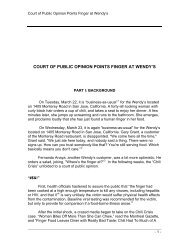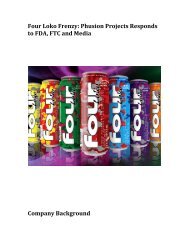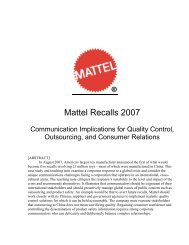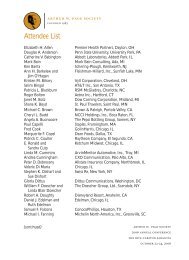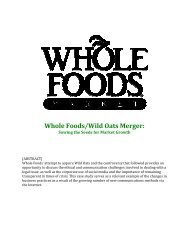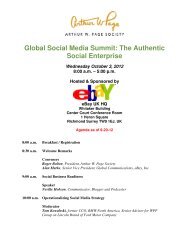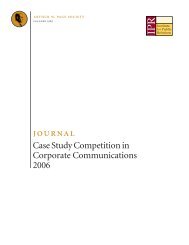Subaru Case Study - The Arthur Page Society
Subaru Case Study - The Arthur Page Society
Subaru Case Study - The Arthur Page Society
Create successful ePaper yourself
Turn your PDF publications into a flip-book with our unique Google optimized e-Paper software.
<strong>Subaru</strong> needs to grow its consumer base by pursuing other niche markets without damaging the<br />
relationships it has cultivated thus far.<br />
THE U.S. AUTOMOTIVE INDUSTRY<br />
According to JD Power and Associates, there are over 40 automotive makers selling<br />
vehicles in the United States today. 4 <strong>The</strong> United States, the largest market for light vehicles in<br />
the world, saw sales of over 13.2 million vehicles in 2008. One year prior, sales exceeded 16.1<br />
million vehicles. 5 See Table I for a breakdown of 2008 U.S. sales by company:<br />
<br />
5 <br />
Source: Ward’s Automotive 6<br />
<strong>The</strong> automotive industry, one of the largest manufacturing industries in the United States<br />
today, has been in turmoil for the past few years due to factors such as the economic recession,<br />
increased oil prices, and poor management decisions. By February 2009, U.S. automotive sales<br />
were the lowest they had been in the past 25 years. 7 American-owned General Motors and<br />
Chrysler received a combined $17.4 billion bailout from the U.S. government in December<br />
2008. 8 A few months later, Chrysler filed for Chapter 11 bankruptcy on April 30, 2009; 9 General<br />
Motors followed suit on June 1, 2009. 10<br />
In 2008, Japanese auto manufacturers led U.S. sales, comprising 47.5% of the market.<br />
American manufacturers comprised 34.8% of total U.S. sales, followed by other foreign imports<br />
(primarily European) at 17.7%. 11<br />
To stimulate sales, the U.S. government initiated the car allowance rebate system<br />
(CARS) on July 1, 2009, 12 commonly referred to as “cash for clunkers.” Under the program, in<br />
exchange for trading in a drivable vehicle 25 years old or newer that received 18 miles per gallon<br />
or fewer, consumers could receive a credit of between $3,500-$4,500 on the purchase of a new,<br />
more fuel efficient vehicle. 13 <strong>The</strong> program lasted until August 25, 2009; 700,000 vehicles were



